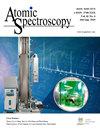A Glimpse Into The Nature Of Particles Created During Pulsed Laser Ablation Of Arsenic Compounds In Ambient Gases
IF 2.3
2区 化学
Q1 SPECTROSCOPY
引用次数: 0
Abstract
: The composition of particles resulting from pulsed laser ablation is not well understood, although it is anticipated that molecules from the ablated material undergo varying degrees of breakdown, depending on factors such as laser wavelength, energy, pulse width, matrix properties, and gas atmosphere. As reliable arsenic characterization and speciation techniques are available, a fundamental study was undertaken to shed light on the behavior of arsenic compounds (arsenic pentoxide, dimethylarsenic acid, and arsenobetaine within a cellulose matrix, along with pure elemental arsenic), using a pulsed 213 nm Nd:YAG laser and ablation in different gas atmospheres (He, Ar/CO 2 [99/1 %], Ar/O 2 [80/20 %], and O 2 ) at atmospheric pressure. The generated arsenic, collected in aerosol form on inline syringe filters (0.2 μm), was subjected to sequential dissolution, yielding water-soluble, HCl-soluble, and insoluble fractions. The water-soluble fraction was analyzed for arsenic species using chromatographic techniques in combination with element-specific detection. The analysis revealed that extremely complex processes take place during laser ablation, not only (partially) stripping organoarsenic species from their methyl groups and lowering the valence state, but also creating conditions for the synthesis of methylated arsenic species from arsenic pentoxide and generating more or less soluble nano/micro/macro particles for all arsenic compounds. These findings contribute to a more nuanced understanding of the multifaceted photochemical transformations that may occur during laser ablation of molecules.环境气体中砷化合物脉冲激光烧蚀过程中产生的微粒性质一瞥
:脉冲激光烧蚀产生的微粒成分尚不十分清楚,但预计烧蚀材料中的分子会发生不同程度的分解,这取决于激光波长、能量、脉冲宽度、基质特性和气体环境等因素。由于已经有了可靠的砷表征和规格技术,因此我们开展了一项基础研究,利用脉冲 213 nm Nd:YAG 激光,在常压下的不同气体环境(He、Ar/CO 2 [99/1 %]、Ar/O 2 [80/20 %] 和 O 2)中进行烧蚀,以揭示砷化合物(纤维素基质中的五氧化二砷、二甲基砷酸和砷甜菜碱,以及纯元素砷)的行为。生成的砷以气溶胶的形式收集到在线注射器过滤器(0.2 μm)中,然后依次溶解,得到水溶性、盐酸溶性和不溶性部分。利用色谱技术结合元素特异性检测对水溶性馏分中的砷物种进行了分析。分析表明,在激光烧蚀过程中发生了极其复杂的过程,不仅(部分)剥离了有机砷物种的甲基基团并降低了价态,还为从五氧化二砷合成甲基化砷物种创造了条件,并为所有砷化合物生成了或多或少可溶的纳米/微米/宏观颗粒。这些发现有助于人们更细致地了解激光烧蚀分子过程中可能发生的多方面光化学转化。
本文章由计算机程序翻译,如有差异,请以英文原文为准。
求助全文
约1分钟内获得全文
求助全文
来源期刊

Atomic Spectroscopy
物理-光谱学
CiteScore
5.30
自引率
14.70%
发文量
42
审稿时长
4.5 months
期刊介绍:
The ATOMIC SPECTROSCOPY is a peer-reviewed international journal started in 1962 by Dr. Walter Slavin and now is published by Atomic Spectroscopy Press Limited (ASPL). It is intended for the rapid publication of both original articles and review articles in the fields of AAS, AFS, ICP-OES, ICP-MS, GD-MS, TIMS, SIMS, AMS, LIBS, XRF and related techniques. Manuscripts dealing with (i) instrumentation & fundamentals, (ii) methodology development & applications, and (iii) standard reference materials (SRMs) development can be submitted for publication.
 求助内容:
求助内容: 应助结果提醒方式:
应助结果提醒方式:


